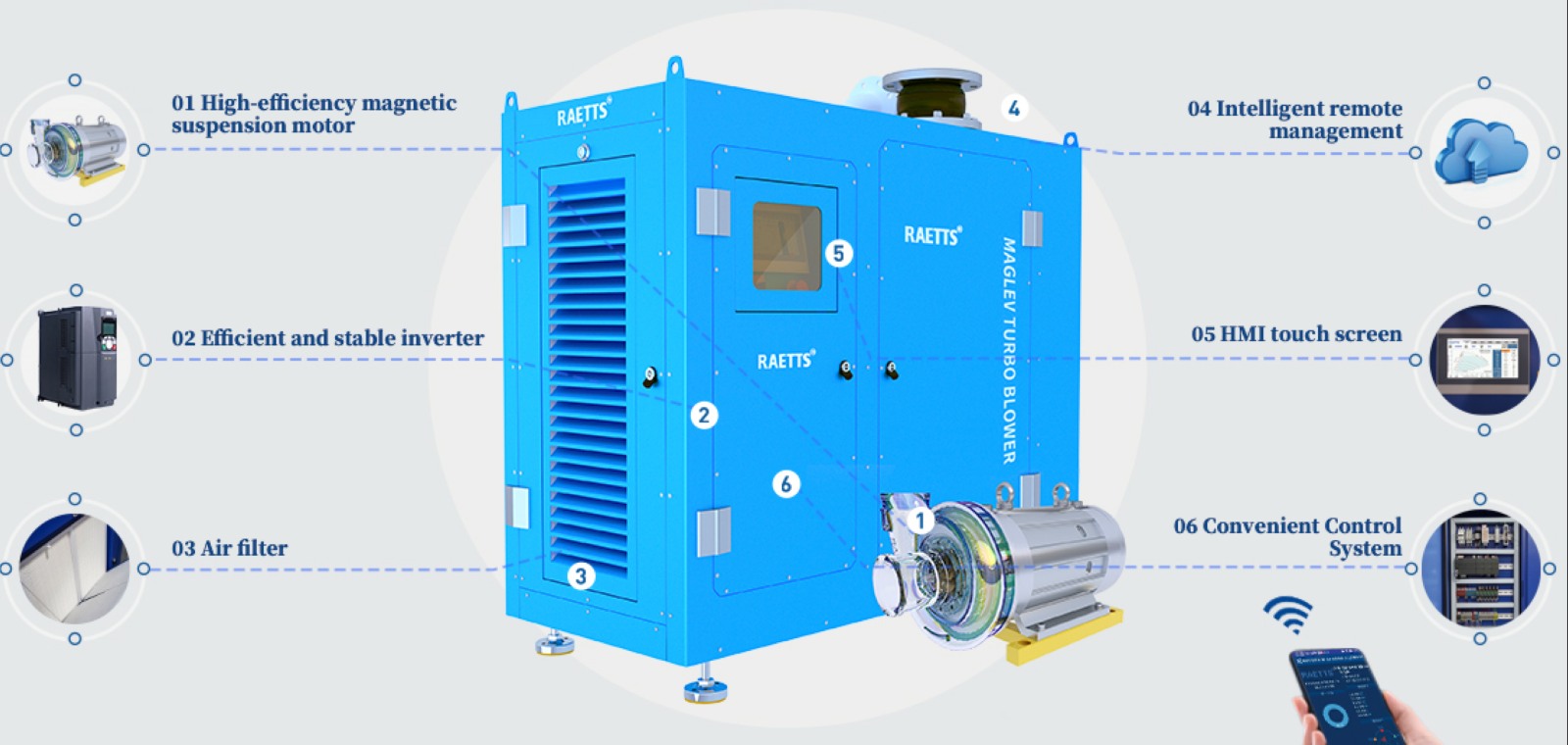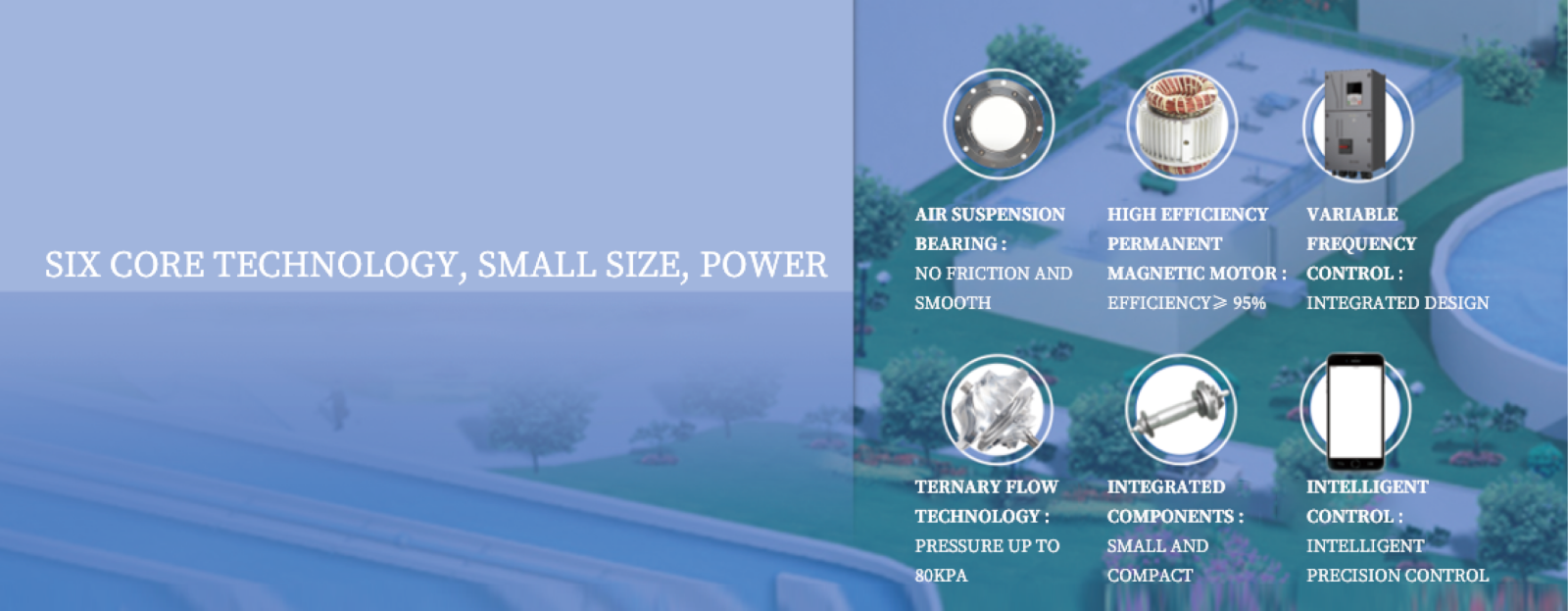Many end user is confused why the blower technology is upgraded to turbo blower? Comparing with traditional roots blower,single-stage and multistage centrifugal blower,RAETTS centrifugal air suspension blower and maglev turbo blower has simple structure:they don’t need coupling connection and oil-lubrication.The daily maintenance of turbo air blower only need to change the dust filter.The main parts of the turbo blower is including high speed permanent magnet synchronous motor(efficiency is about 97%),ternary flow impeller(Variable efficiency up to 87%),suspension bearing(air foil bearing or maglev bearing),VFD, and PLC control system.The traditional industrial air blowers normally use three-phase asynchronous motor(efficiency is about 88%),lobe impeller(efficiency is about 60%),ball bearing,belt or coupling connection.Since the air turbo blowers don’t need belt or coupling for connection,so there is not energy lost during transmission.The efficiency of the turbo blower is about 76% while the roots air blower efficiency is about 40% and multistage air blower efficiency is about 50%.The total energy saving of centrifugal turbo blower is about 25%-30%,comparing with traditional roots blower or other type centrifugal blower.

| Product name | biology wastewater treatment blower |
| Keyword | industrial blowers for powder and bulk solid pneumatic conveying,air blower for Textile ,wastewater treatment blowers,Aeration Blower For Paper Industry,magnetic bearing turbo blower,positive displacement blowers for pressure conveying systems |
| Place of Origin | China |
| Feature | RAETTS air bearing turbo blower is a brand-new concept blower, which integrates the main core technologies such as “air suspension bearing”, “permanent magnet ultra-high-speed motor”, “high-precision aviation-grade impeller”, and creates a new era of ultra-high efficiency ,low noise and low energy consumption. |
| Dimensions | 792mm*749mm*792mm, (Contact us for specific information to confirm) |
| Applicable Industries | thermal power plant, etc. |
| Weight | 227kg |
| delivery date | the common delivery time will be 30-40 days. |
| terms of paymen | RAETTS accept payment by T/T(30% advance payment,70% before shipment) |
| Life span | 15 years (Contact us for specific information to confirm) |
| After-sale service | RAETTS warranty time for air bearing blower and maglev turbo blower is 24months,for high speed centrifugal blower is 12 months. |
| Advantage | We keep good quality and competitive price to ensure our customers benefit |
| Packing | 875x845x853mm(Contact us for specific information to confirm) |
| OEM/ODM | Customization Service Provided |
| Sales country | All over the world for example:Vietnam,Gibraltar,Nauru,Samoa,Morocco,Chad,Antarctica,Nepal |
| MOQ | 4pcs(Contact us for specific information to confirm) |
| production capacity | production capacity RAETTS production quantity for air bearing blower and maglev turbo blower is about 200pcs/month,for high speed centrifugal blower is about 700pcs/month. |
| raw materials | RAETTS air blower impeller in made of aluminum alloy,enclosure material is carbon steel,rotor material is cast iron.If customers need other special materials,we can also customized according to customers requirements |
| technology | RAETTS air bearing blower technology is originated from South Korea and maglev turbo blower technology is originated from Germany.RAETTS also have R&D team from Xi’an Jiaotong University |
| quality system | RAETTS has quality management system certificate ISO9001:2015 and enviromental management system certificate ISO14001:2015 |



biology wastewater treatment blower services FAQs Guide
Are you looking for a quick review guide about biology wastewater treatment blowerservices?
An ultimate FAQ buying guide is available to help you.This guide contains all the information about all the important facts, figures, and various processes regarding biology wastewater treatment blower services.
Let’s continue!
2.What Type of Filter is Recommended for Use with a Turbo Blower?
3.Can a Turbo Blower Be Used for Both Vacuum and Compression Applications?
4.What are the different types of biology wastewater treatment blower available in the market?
5.About the scale of biology wastewater treatment blower factory
6.What Are the Advantages of Choosing a High-Speed Turbo Blower?
7.Are There Environmental Benefits to Using a Turbo Blower?
8.About biology wastewater treatment blower payment method
9.What is the Overall Efficiency Rating of a Turbo Blower?
1.About biology wastewater treatment blower overseas warehouse
RAETTS is cooperating with global distributors,some distributors has stock or sample in their warehouse.For now,RAETTS has Germany factory warehouse,and we are building the USA warehouse.
2.What Type of Filter is Recommended for Use with a Turbo Blower?
We are centered on customers and always pay attention to customers’ needs for biology wastewater treatment blower products.
A high-efficiency particulate air (HEPA) filter is recommended for use with a turbo blower. This type of filter is designed to capture small particles and contaminants, making it ideal for use with a turbo blower which can generate high air flow rates. HEPA filters are also commonly used in industrial and medical settings where clean air is crucial.
3.Can a Turbo Blower Be Used for Both Vacuum and Compression Applications?
We have broad development space in domestic and foreign markets. biology wastewater treatment blower have great advantages in terms of price, quality, and delivery date.
Yes, a turbo blower can be used for both vacuum and compression applications. Turbo blowers are versatile machines that can be used for a variety of applications, including both vacuum and compression. They are commonly used in industries such as wastewater treatment, pneumatic conveying, and industrial processes.
In vacuum applications, the turbo blower is used to create a negative pressure or suction to remove air or other gases from a system. This is commonly used in vacuum pumps for packaging, vacuum cleaners, and other industrial processes.
In compression applications, the turbo blower is used to increase the pressure of a gas or air stream. This is commonly used in pneumatic conveying systems, aeration systems, and other industrial processes.
The versatility of turbo blowers makes them a popular choice for many industries. They are energy-efficient, compact, and have a wide operating range, making them suitable for various applications. However, it is essential to ensure that the turbo blower is designed and selected specifically for the intended application to ensure optimal performance and efficiency.
4.What are the different types of biology wastewater treatment blower available in the market?
For the industrial air blower,normally it is including side channel blower(also called ring blower),roots blower(also called lobe blower),single-stage centrifugal blower,multi-stage centrifugal blower,air foil bearing blowers and maglev turbo blowers.
5.About the scale of biology wastewater treatment blower factory
For now,RAETTS has 3 factory:
Ganzhou standard product production base:30000m2;
Dongguan R&D product production base:20000m2;
Germany production base:2000m2;
6.What Are the Advantages of Choosing a High-Speed Turbo Blower?
We have the leading technology and innovation capabilities, and attach importance to employee training and development, and provide promotion opportunities.
1. Energy Efficiency: High-speed turbo blowers are designed to operate at high speeds, which results in higher energy efficiency compared to traditional blowers. This means lower energy consumption and cost savings for the user.
2. Compact Size: High-speed turbo blowers are smaller in size compared to traditional blowers, making them ideal for applications where space is limited. This also makes them easier to install and maintain.
3. Low Noise Levels: High-speed turbo blowers operate at a much lower noise level compared to traditional blowers, making them suitable for use in noise-sensitive environments.
4. Low Maintenance: High-speed turbo blowers have fewer moving parts compared to traditional blowers, resulting in lower maintenance requirements and costs.
5. Wide Operating Range: High-speed turbo blowers have a wide operating range, allowing them to maintain a consistent flow and pressure even when there are fluctuations in demand.
6. Durability: High-speed turbo blowers are designed to be highly durable and have a longer lifespan compared to traditional blowers, resulting in lower replacement and maintenance costs.
7. Flexibility: High-speed turbo blowers can be used for a variety of applications, including aeration, ventilation, and pneumatic conveying, making them a versatile choice for different industries.
8. Environmentally Friendly: High-speed turbo blowers are designed to be environmentally friendly, with lower emissions and energy consumption compared to traditional blowers.
9. Faster Start-Up Time: High-speed turbo blowers have a faster start-up time compared to traditional blowers, allowing for quicker response to changes in demand.
10. Advanced Control Options: High-speed turbo blowers come with advanced control options, such as variable frequency drives, allowing for precise control of air flow and pressure. This results in better process control and energy savings.
7.Are There Environmental Benefits to Using a Turbo Blower?
Our mission is to provide customers with the best solutions for biology wastewater treatment blower.
Yes, there are several environmental benefits to using a turbo blower:
1. Energy Efficiency: Turbo blowers are more energy efficient compared to traditional blowers, which means they consume less energy to produce the same amount of air flow. This results in lower energy consumption and reduced carbon emissions.
2. Reduced Noise Pollution: Turbo blowers are designed to operate at lower noise levels compared to traditional blowers. This helps to reduce noise pollution in the surrounding environment, making them ideal for use in residential areas or noise-sensitive locations.
3. Lower Maintenance Requirements: Turbo blowers have fewer moving parts compared to traditional blowers, which means they require less maintenance and have a longer lifespan. This reduces the need for frequent replacements and disposal of old equipment, resulting in less waste and environmental impact.
4. Reduced Carbon Footprint: As turbo blowers are more energy efficient, they help to reduce the carbon footprint of the facility where they are used. This is beneficial for the environment as it helps to mitigate the effects of climate change.
5. Improved Air Quality: Turbo blowers are designed to provide a consistent and clean air flow, which helps to improve the air quality in the surrounding environment. This is especially important in industrial settings where air pollution can be a major concern.
6. Reduced Water Usage: Some turbo blowers are designed to use water as a lubricant, which reduces the need for oil or other lubricants. This helps to conserve water resources and reduce the risk of water pollution.
Overall, using a turbo blower can have a positive impact on the environment by reducing energy consumption, noise pollution, carbon emissions, and water usage, while also improving air quality and reducing maintenance requirements.
8.About biology wastewater treatment blower payment method
RAETTS accept payment by T/T(30% advance payment,70% before shipment)
9.What is the Overall Efficiency Rating of a Turbo Blower?
We are a new biology wastewater treatment blower manufacturer.
The overall efficiency rating of a turbo blower can vary depending on the specific model and manufacturer. However, on average, turbo blowers have an overall efficiency rating of around 70-80%. This means that for every 100 units of energy input, the turbo blower can produce 70-80 units of output energy. Factors such as design, size, and operating conditions can also affect the efficiency of a turbo blower.
Tag:blower pneumatic conveying systems,turbo blower wastewater treatment,Mineral processing blower,turbo blower,centrifugal air suspension blower,magnetic levitation blower,air blower for hospital sewage wastewater treatment plant,air foil bearing blower








